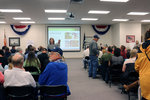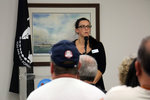

The first of two meetings focused on garnering public comment on the Department of Ecology’s Draft Programmatic Environmental Impact Statement for the Chehalis River Basin was held on Tuesday night at the Veterans Memorial Museum in Chehalis, where it was standing room only.
More than 200 local leaders and community members attended the meeting, with 35 providing comments.
The discussion largely boiled down to two alternatives, one of which the majority favored, and the second, one the community largely opposed.
The majority of speakers favored Alternative One, which includes building a dam near Pe Ell on the Chehalis River. The alternative was recommended by the 2014 Governor’s Work Group.
Many of those who spoke in favor of Alternative One were also strongly opposed to Alternative Four, which includes restorative flood protection. Under this alternative, the state would purchase 21,000 acres of riverfront land in the upper basin from willing landowners. Farms in the floodplains would be moved to surrounding hillsides that were cleared of trees.
Those who spoke in opposition of Alternative Four said the hillsides do not provide the same quality of soil as in the lower basin.
Greg Lund, a local real estate agent, said the soil on the hillsides is “inferior,” and also said there are no good water sources for the farmers.
“It just boggles my mind that you’re going to think you are going to buy out this farmer who has spent his life at assessed value and he has to replace that,” he said.
Lund’s statements about assessed value were similar to that of Glenn Carter, with the Lewis County Prosecutor’s Office, who stated assessed value carries artificially lower costs of purchase than are otherwise realistic.
Several members of Bethel Church also strongly opposed Alternative Four, in part because it would force the church to find a new location.
“I don’t see that as a possibility for us,” Kyle Rasmussen, the lead pastor at Bethel, said. “… Lots of families would be affected in a serious way.”
Some of those favoring Alternative One, or the dam, stated the project will help more people than any of the other alternatives.
“Alternative One does the most good for the most people,” David Fenn, a Lewis County resident said. “Alternative Four picks sides. It takes four small communities and puts those communities in jeopardy in terms of being sustainable, functionally good communities, and I find that wholly inappropriate, even the idea of it.”
Several at the meeting said they could not support any alternatives, primarily because they still have too many unanswered questions.
“I think we are rushing here to get something done,” Duane Bryant, a farm owner on U.S. Highway 12, said. “I think I’ve studied this longer than anyone in this room and I get more questions every time I’ve come to meetings. I’ve been to dozens and dozens … I think we are rushing and missing some things that could be done with the money.”
Jay Gordon, a sixth-generation farmer and member of the Governor’s Work Group, thanked those who spoke at the meeting, and said it was the most respectful and thoughtful presentation he had been a part of.
He said there had been 830 studies done on the flooding issue of the area.
“This valley has finally come together,” he said.
Thirty-five people provided comments on the alternatives at Tuesday’s meeting.
According to Jessica Payne, communications manager for the state Department of Ecology, as of Monday around 4 p.m., the department had received 37 official comments on the Programmatic Environmental Impact Statement.
“I am excited to see how many we receive this week after last night’s public hearing,” she said.
The next meeting will be held on Thursday, Oct. 27 at Montesano City Hall, 112 N. Main St.
It will follow the same format as the meeting at the Veterans Memorial Museum and will have an open house at 6 p.m., followed by a short presentation at 6:30 p.m., and a public hearing at 7 p.m.
Fran Sant, the hearing officer on Tuesday night, said the public comment period for the draft EIS closes Oct. 31. Comments from both of the meetings will be part of the official record, as will written comments received by Ecology.
The next steps will consider the comments, and prepare the final State Environmental Policy Act EIS. Comments and responses will be included. That is expected to be released in 2017.